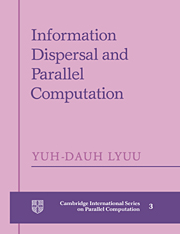Book contents
- Frontmatter
- Contents
- List of Figures
- Preface
- Acknowledgments
- Glossary of Notations
- 1 Introduction
- 2 Information Dispersal
- 3 Interconnection Networks
- 4 Introduction to Parallel Routing
- 5 Fault-Tolerant Routing Schemes and Analysis
- 6 Simulation of the PRAM
- 7 Asynchronism and Sensitivity
- 8 On-Line Maintenance
- 9 A Fault-Tolerant Parallel Computer
- Bibliography
- Index
6 - Simulation of the PRAM
Published online by Cambridge University Press: 03 October 2009
- Frontmatter
- Contents
- List of Figures
- Preface
- Acknowledgments
- Glossary of Notations
- 1 Introduction
- 2 Information Dispersal
- 3 Interconnection Networks
- 4 Introduction to Parallel Routing
- 5 Fault-Tolerant Routing Schemes and Analysis
- 6 Simulation of the PRAM
- 7 Asynchronism and Sensitivity
- 8 On-Line Maintenance
- 9 A Fault-Tolerant Parallel Computer
- Bibliography
- Index
Summary
But it is the theory of another world […].
—Joseph Alois SchumpeterThe simulation of the ideal parallel computation model, pram, on the hypercube network is considered in this chapter. It is shown that a class of pram programs can be simulated with a slowdown of O(log N) with almost certainty and without using hashing, where N denotes the number of processors. Also shown is that general pram programs can be simulated with a slowdown of O(log N) with the help of hashing. Both schemes are ida-based and fault-tolerant.
Introduction
Parallel algorithms are notoriously hard to write and debug. Hence, it is only natural to turn to ideal models that provide good abstraction. As these models do not assume any particular hardware configuration, they should have the additional benefit that programs written for them can be executed on any hardware that supports the model, similar to the situation in the sequential case where the existence of a, say, C compiler on a particular platform implies standard C programs can be compiled and executed there [370]. The PRAM (“Parallel Random Access Machine”) is one such model. It completely abstracts out the cost issue in communication and allows us to focus on the computational aspect. However, such convenience and generality is not without its price: the PRAM model, unlike the von Neumann machine model, is not physically feasible to build [369]. The simulation of PRAMs by feasible computers is therefore important and forms the major theme of this chapter.
- Type
- Chapter
- Information
- Information Dispersal and Parallel Computation , pp. 86 - 109Publisher: Cambridge University PressPrint publication year: 1993



